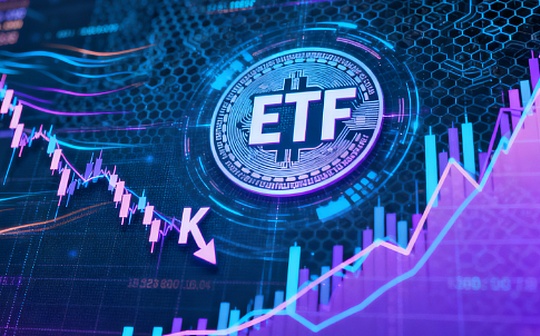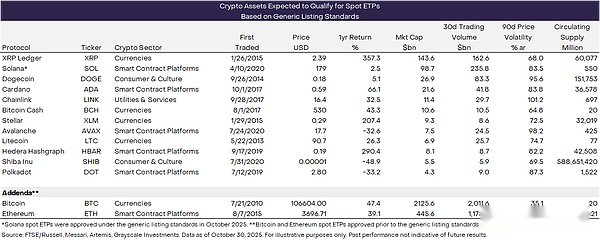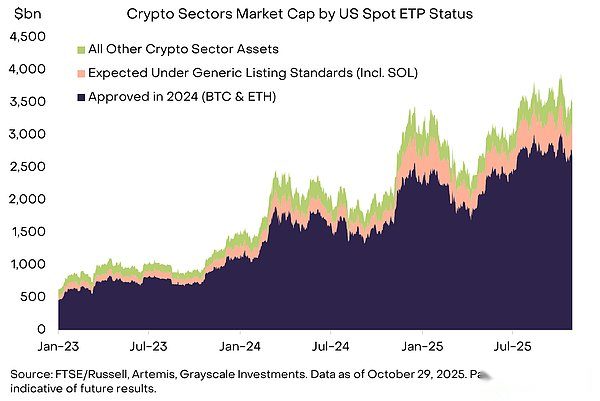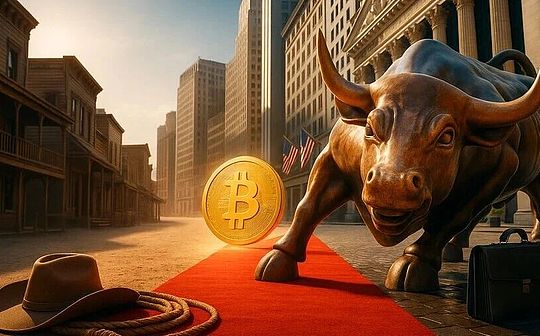
Source: Grayscale; Compiled by: Bitchain Vision
In the coming weeks, due to new guidance from U.S. regulators,Investors can expect a significant increase in the number of exchange-traded products (ETPs) offering exposure to “altcoins” (cryptoassets with a smaller market capitalization than Bitcoin).These crypto-assets represent a wide variety of application scenarios and demonstrate the versatility of public blockchain technology.
An exchange-traded product (ETP) offering spot trading of the Solana Network’s SOL token has begun trading.In the coming weeks, the number of “altcoins” (cryptoassets with a smaller market capitalization than Bitcoin) that can be traded through spot ETP products is likely to increase significantly due to recent regulatory changes.
It took more than ten years to introduce Bitcoin ETP to the U.S. market, from the first application submission in 2013 to its official listing in 2024.For new cryptocurrency ETPs, investors can expect a more streamlined listing process.On September 17, the U.S. Securities and Exchange Commission (SEC) approved common listing standards for crypto-asset ETPs.Instead of examining each token individually, the SEC will evaluate whether the asset meets certain general criteria.If these criteria are met, the exchange can list and trade the ETP for the token after the ETP issues a valid registration statement.
In addition to Solana, Grayscale expects 11 different cryptoassets to be eligible for listing as ETPs under the Common Listing Criteria (see Exhibit 1).Over time, the number of cryptoassets that meet the new standards is likely to increase further.
Exhibit 1: Multi-asset portfolios may soon be available as U.S. exchange-traded products (ETPs).

Public blockchain is a versatile technology with a wide range of uses, and crypto asset classes are increasingly diverse.To better categorize, Grayscale uses a proprietary taxonomy and index tool called Crypto Sectors, which was developed by Grayscale in partnership with FTSE/Russell (see Exhibit 2).
Exhibit 2: Crypto sector framework helps organize digital asset markets

Under the new common listing standards, ETP-eligible altcoins (including Solana) cover four of the six major cryptocurrency sectors and account for approximately 11% of the total market capitalization of the cryptocurrency sector (see chart 3).Together with Bitcoin and Ethereum, the assets that U.S. investors can invest in through spot ETP products will account for approximately 90% of the total market capitalization of the cryptocurrency sector.
Exhibit 3: Crypto sector framework helps organize digital asset markets

The following is a brief overview of 14 ETP assets currently listed or about to be listed,Includes 12 altcoins, and sorted by market capitalization.Investors should consider the unique uses and risks of each token, as well as the potential benefits of holding a diversified portfolio of crypto assets.
Bitcoin (BTC)
Market Cap: $2.2 trillion; Crypto Sector: Currency
Bitcoin is the first decentralized blockchain network, a peer-to-peer digital currency designed to enable secure, trustless transactions without intermediaries.Bitcoin’s supply is transparent, predictable, and capped at 21 million coins.Like physical gold, part of Bitcoin’s utility stems from its immutable and independent nature from political systems.
Ethereum (ETH)
Market value: US$466 billion; Crypto sector: smart contract platform
Ethereum is a smart contract platform that underpins many aspects of blockchain finance, including stablecoins, tokenized assets and decentralized finance (DeFi).Unlike many other blockchains, activity in the Ethereum ecosystem occurs both on the Ethereum mainnet (Layer 1) and on numerous second-layer networks (Layer 2).
XRP Ledger(XRP)
Market Cap: $150 billion; Crypto Sector: Currency
The XRP Ledger (XRPL) is a mature blockchain designed to improve cross-border payments and bring other digital financial innovations.Created in 2012, XRP remains one of the largest and most widely traded digital assets.
Solana (SOL)
Market value: US$103 billion; Crypto sector: smart contract platform
Solana is a smart contract platform blockchain that stands out due to the depth and diversity of its on-chain activities.Today, it leads in terms of number of users, transaction volume, and transaction fees—arguably the three most important metrics for measuring blockchain activity.
Dogecoin (DOGE)
Market value: US$28 billion; Crypto sector: consumption and culture
Dogecoin is a fully functional blockchain, similar to XRP Ledger or Solana, but it is based on the “Doge” network meme – a Shiba Inu that has quickly become popular around the world.Meme coins can be seen as tokenized and investable manifestations of internet culture.Dogecoin’s community culture and viral origins have contributed to its enduring popularity.
Cardano (ADA)
Market value: US$23 billion; Crypto sector: smart contract platform
Cardano is a smart contract blockchain developed based on peer-reviewed academic research and powered by an active community around the world.The ADA token powers the Cardano network, enabling users to stake tokens, participate in governance, and pay for transactions.
Chainlink(LINK)
Market Cap: $12 billion; Crypto Sector: Utilities and Services
Chainlink is a decentralized oracle platform designed to connect smart contracts with real-world data, cross-chain messaging and off-chain systems, providing secure middleware that enables tokenized assets, decentralized finance and enterprise-grade blockchain applications to run reliably.LINK token is Chainlink’s native utility token, used to pay for oracle service fees, reward node operators, and serves as an economic and pledged asset to coordinate incentive mechanisms and ensure the security of the Chainlink network.
Bitcoin Cash (BCH)
Market Cap: $11 billion; Crypto Sector: Currency
Bitcoin Cash is a peer-to-peer electronic cash system that was created following the 2017 Bitcoin hard fork.Previously, there was a heated debate surrounding Bitcoin’s scaling issue—that is, whether and how to improve Bitcoin to provide faster and cheaper transactions.Bitcoin Cash attempts to achieve greater scalability by allowing each block to contain more bytes.
Stellar (XLM)
Market Cap: $10 billion; Crypto Sector: Currency
Stellar is a decentralized payments network designed to facilitate fast, low-cost cross-border transfers between currencies and financial institutions, with a focus on connecting traditional banking systems with blockchain-based settlement systems.Lumen Token (XLM) is Stellar’s native token, used to pay transaction fees, help prevent network spam, and serve as a bridge currency to achieve efficient exchange between different legal currencies and digital assets.
Avalance(AVAX)
Market value: US$8 billion; Crypto sector: smart contract platform
Avalanche is a smart contract platform blockchain that provides highly customized solutions for different application scenarios.With its unique design choices, the Avalanche protocol has evolved over time into a diverse, flexible, and multifaceted ecosystem.
Litecoin (LTC)
Market Cap: $7.3 billion; Crypto Sector: Currency
Litecoin is a decentralized digital currency that offers fast, low-cost global payments, making it a practical alternative to Bitcoin in everyday use.It is based on Bitcoin’s source code, but blocks are generated faster and transaction costs are lower.Litecoin also offers some privacy protection features.
Hedera Hashgraph (HBAR)
Market value: US$8.4 billion; Crypto sector: smart contract platform
Hedera is a “permissioned” smart contract platform blockchain governed by a council of major institutions.Anyone can create applications for the Hedera network, but only designated entities can participate in network consensus and validate transactions.
Shiba Inu(SHIB)
Market value: US$5.9 billion; Crypto sector: consumption and culture
Similar to Dogecoin, Shib Token is a dog-themed meme coin that has economic value as a digital collectible.But unlike Dogecoin, Shib does not run independently on the blockchain, but exists as a token on the Ethereum blockchain.
Polkadot(DOT)
Market value: US$4.4 billion; Crypto sector: smart contract platform
Polkadot is a blockchain protocol designed to be the connecting link for Web 3.0 – a vision for digital commerce based on blockchain technology originally proposed by Gavin Wood, founder of Polkadot and co-founder of Ethereum.In the Polkadot ecosystem, specialized blockchains called parachains are connected through a coordinated relay chain.








